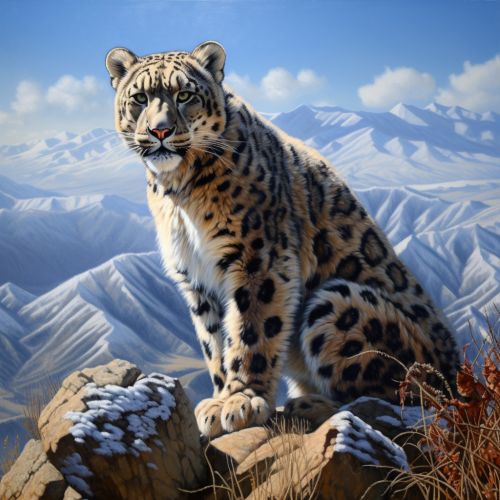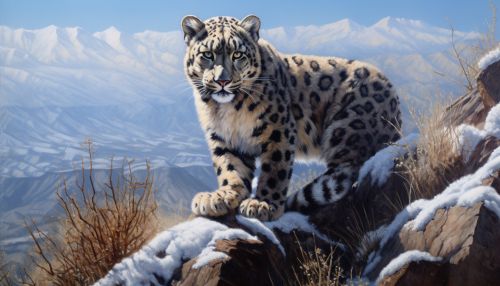Snow Leopard
Taxonomy and Evolution
The Snow Leopard (Panthera uncia), also known as the ounce, is a large cat species native to the mountain ranges of Central and South Asia. It is listed as Vulnerable on the IUCN Red List because the global population is estimated to number less than 10,000 mature individuals and is expected to decline about 10% by 2040. It is a member of the Panthera genus, one of the five big cats in the genus, along with the lion, tiger, jaguar, and leopard.


The snow leopard was first described by the German naturalist Johann Christian Daniel von Schreber in 1777. The generic name, Panthera, is derived from the Latin word panther, while the species name, uncia, is from the Latin word uncia which was originally used to refer to a weight.
Physical Characteristics
Snow leopards are slightly smaller than the other big cats but, like them, exhibit a range of sizes, generally weighing between 27 and 55 kg (60 and 121 lb), with an occasional large male reaching 75 kg (165 lb) and small female of under 25 kg (55 lb). They have a relatively short body, measuring in length from the head to the base of the tail 75 to 130 cm (30 to 50 in). However, the tail is quite long, at 80 to 105 cm (31 to 41 in) in length, with only the domestic-cat-sized Marbled Cat being relatively longer-tailed. They are stocky and short-legged big cats, standing about 60 cm (24 in) at the shoulder.
Snow leopards have long, thick fur, and their base color varies from smoky gray to yellowish tan, with whitish underparts. They have dark grey to black open rosettes on their bodies, with small spots of the same color on their heads and larger spots on their legs and tails. Unusually among cats, their eyes are pale green or gray in color.
Habitat and Distribution
Snow leopards are native to the mountain ranges of Central and South Asia, including the Himalayas, and the Tian Shan, Karakoram, Pamir, Hindu Kush, and Altai. They are found in 12 countries: Afghanistan, Bhutan, China, India, Kazakhstan, Kyrgyzstan, Mongolia, Nepal, Pakistan, Russia, Tajikistan, and Uzbekistan.
They inhabit alpine and subalpine zones at elevations from 3,000 to 4,500 m (9,800 to 14,800 ft), where the environment is harsh and arid. In the northern range countries, they also occur at lower elevations.
Behavior and Ecology
Snow leopards are solitary animals, with males and females only coming together during the mating season. They are also very agile and known for their ability to climb steep cliffs and precipices. They are primarily a crepuscular species, being most active at dawn and dusk.
Their diet consists mainly of ungulates and smaller mammals, including Himalayan tahrs, argali, ibex, marmots, pikas, and snowcocks. They are also known to eat a significant amount of vegetation, including grass and twigs.
Conservation
The snow leopard is listed as Vulnerable on the IUCN Red List of Threatened Species because, as of 2003, the size of the global population was estimated at 4,080–6,590 adults. Many of these are in non-protected areas, which are subject to habitat loss, poaching, and depletion of prey.
Efforts have been made to conserve the species, including legal protection in several countries, captive breeding programs, and various conservation projects initiated by the Snow Leopard Trust and other organizations.
